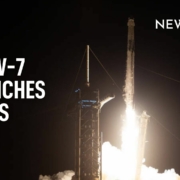Crew-7 launches to ISS
Crew-7 successfully launches to the International Space Station, from Launch Complex 39A at NASA’s Kennedy Space Center in Florida, on SpaceX’s Endurance Dragon spacecraft, powered by a Falcon 9 rocket. The crew includes: NASA astronaut Jasmin Moghbeli, European Space Agency (ESA) astronaut Andreas Mogensen, Japan Aerospace Exploration Agency (JAXA) astronaut Satoshi Furukawa, and Konstantin Borisov of Russia’s space agency. Over 200 science experiments and technology demonstrations will take place during Crew-7’s mission of approximately six months in space. Experiments will include the collection of microbial samples from the exterior of the space station, the first study of human response to different spaceflight durations, and an investigation of the physiological aspects of astronauts’ sleep. NASA Administrator Bill Nelson:
Crew-7 is a shining example of the power of both American ingenuity and what we can accomplish when we work together. Aboard station, the crew will conduct more than 200 science experiments and technology demonstrations to prepare for missions to the Moon, Mars, and beyond, all while benefitting humanity on Earth. By partnering with countries around the world, NASA is engaging the best scientific minds to enable our bold missions, and it’s clear that we can do more – and we can learn more – when we work together.
SpaceX, NASA move ahead with second Dragon launch pad
SpaceX and NASA officials confirm they are moving forward with plans to modify the LC-40 launch pad to support Crew and Cargo Dragon missions. SpaceX began studying the possibility of modifying the pad earlier this year, after NASA raised concerns about the risks posed by plans to operate its next-generation Starship rocket out of LC-39, which is currently used for Dragon missions. Likely modifications include building a new crew access tower, crew access arm, escape system (39A uses baskets and ziplines), and an on-site bunker for astronauts.
NASA's Steve Stitch says that SpaceX and NASA continue to look at outfitting SLC-40 for Dragon missions given Starship work at 39A. SpaceX's Gerst says that hardware is already in work to prepare SLC-40. Starship will only come to 39A after it is proven reliable in Texas.
— Michael Baylor (@nextspaceflight) September 26, 2022
‘Impossible engine’ works in tests
NASA conducts more tests of its ‘impossible engine’, and the first public update in months suggests fuel-free thrusters do work — but they don’t know why. Paul March, one of the top engineers working the EM Drive thruster at the Eagleworks Laboratory at the Johnson Space Center in Texas, posts the update on the NASA Spaceflight forum in response to a claim the unaccounted thrust is generated by something known as the Lorentz force, a force that is exerted by a magnetic field on a moving electric charge. March says his tests prove this is not true.
I will tell you that we first built and installed a second generation, closed face magnetic damper that reduced the stray magnetic fields in the vacuum chamber by at least an order of magnitude and any Lorentz force interactions it could produce, and yet the anomalous thrust signals remain.
March says they have managed to remove some of the errors from earlier tests – but still found signals of unexplained thrust.
15 years continuous habitation
The ISS celebrates 15 years of continuous human habitation. In that time over 220 astronauts, cosmonauts and fee-paying space tourists have visited the station. NASA:
It is the blueprint for global cooperation. One that enables a multinational partnership and advances shared goals in space exploration.
Water and ice found
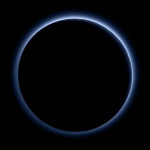 NASA says that Pluto has traces of water and ice on its surface. Red-colored frozen surface water is confirmed by combining spectral infrared and visible light data taken by two of New Horizons’ image sensors. The agency also releases a picture of Pluto’s blue sky, which is caused by tiny, sunlight-scattering particles in the atmosphere. Those particles probably begin as molecular nitrogen (which Pluto is constantly emitting) and other trace gases.
NASA says that Pluto has traces of water and ice on its surface. Red-colored frozen surface water is confirmed by combining spectral infrared and visible light data taken by two of New Horizons’ image sensors. The agency also releases a picture of Pluto’s blue sky, which is caused by tiny, sunlight-scattering particles in the atmosphere. Those particles probably begin as molecular nitrogen (which Pluto is constantly emitting) and other trace gases.
Charon detailed images
NASA releases detailed photos and a flyover animation of Charon, taken by New Horizons when it made its close flyby of Pluto on July 14. Scientists say they expected to find a long-dead world pocked with craters, but instead the surface plays host to mountains, a red north pole and a host of other geological features including a canyon more than 1,000 miles wide that stretches across the moon’s Pluto-facing side, and perhaps along the far-side of the world. That canyon is probably four times longer than the Grand Canyon is on Earth, and twice as deep in some places.
We thought the probability of seeing such interesting features on this satellite of a world at the far edge of our solar system was low, but [we] couldn’t be more delighted with what we see.
Flowing water found on Mars
NASA says ‘dark finger-style’ marks that change with the seasons and were first spotted in 2011 by Ojha, using images taken by the Mars Reconnaissance Orbiter, are signs of water flowing under the surface of Mars. Ojha investigated the composition of these seasonal flows by studying their infrared wavelengths. In each location researchers found the presence of hydrated salts during the times when the flows are most extensive – suggesting a link between the two. In particular, evidence was found for sodium perchlorate, magnesium perchlorate and magnesium chlorate which are thought to be left behind when brine evaporates. Ohta:
The only thing we can really assert is that the places we’re finding are probably more habitable than the rest of the planet, which is bone dry.
Pluto hi-resolution images
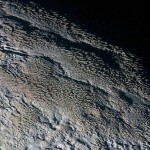 NASA releases high resolution New Horizons images of Pluto’s surface that show rippling terrain that stretches many hundreds of km. Team member:
NASA releases high resolution New Horizons images of Pluto’s surface that show rippling terrain that stretches many hundreds of km. Team member:
It looks more like tree bark or dragon scales than geology. This’ll really take time to figure out; maybe it’s some combination of internal tectonic forces and ice sublimation driven by Pluto’s faint sunlight.
The ripples are part of a 70MB image (link) that combines images from the probe’s Ralph/Multispectral Visual Imaging Camera, that combines blue, red and near infrared (NIR) images.
Tens of millions of Pluto pixels, in color. The highest-res enhanced-color view of Pluto yet. http://t.co/jSZ2Fqyo6q pic.twitter.com/VJUsoZwMlM
— Dr. Alex Parker (@Alex_Parker) September 24, 2015
Next flyby target selected
NASA determines the next likely target destination for a flyby by New Horizons, a small object in the Kuiper Belt called 2014MU69. It orbits almost a billion miles away from Pluto. A full proposal about the mission will be evaluated by NASA experts before the go ahead is officially given. NASA Science Mission Directorate Chief Grunsfeld:
Even as the New Horizon’s spacecraft speeds away from Pluto out into the Kuiper Belt, and the data from the exciting encounter with this new world is being streamed back to Earth, we are looking outward to the next destination for this intrepid explorer. While discussions whether to approve this extended mission will take place in the larger context of the planetary science portfolio, we expect it to be much less expensive than the prime mission while still providing new and exciting science.
Eat lettuce grown in ISS
NASA astronauts on the International Space Station eat red romaine lettuce, which they freshly harvested from the orbiting lab’s vegetable plant growth system. The space garden snack marks the first time NASA had cleared its astronauts to eat what they grew. Before eating, they clean the lettuce with citric acid-based sanitizing wipes.
Lindgren: That’s awesome
Yui: I like that
Kelly: It tastes like arugula
The three save a few leaves for their Russian cosmonaut crewmates, two of whom are out on a spacewalk. Half of the harvest is frozen on the station so it can be returned to Earth for scientific analysis.
It was one small bite for man, one giant leap for #NASAVEGGIE and our #JourneytoMars. #YearInSpacehttps://t.co/B7Gkfm1Vz0
— Scott Kelly (@StationCDRKelly) August 10, 2015
Aurora footage
Kelly tweets footage of the Aurora Borealis, otherwise known as the Northern Lights, taken just before sunrise from the International Space Station, on the 141st day of his #yearinspace mission.
Day 141. The chapter of a day ends as it began. #Aurora on a sunrise. Good night from @space_station! #YearInSpacehttps://t.co/hZBMs9q0CS
— Scott Kelly (@StationCDRKelly) August 15, 2015
Joins tumblr
NASA starts multiple blogs on tumblr. It will share photos, text and videos in its main blog. The second blog is by astronaut Peggy Whitson who chronicles her training. The third microblog posts photos of Jupiter taken by NASA’s Juno mission and other astronomers. The last blog is by Curiosity Rover from Mars.
The agency continues to add new platforms like Tumblr to offer the public a comprehensive view of NASA’s missions, facilities and people.
NASA anticipates greater discoveries
Speaking before the House Committee on Science, Space and Technology, Stern says scientific information gleaned from the New Horizons mission to Pluto is “revolutionizing” what they know about the icy dwarf planet, predicting that even greater discoveries lay ahead.
With only 5% of data on the ground, we all feel we need to fasten our seat belts for the next 95%.
It will take 16 months for all the collected data from New Horizons to be transmitted to Earth. Scientists say the mission demonstrates this need for further planetary exploration.
Now is the time to accelerate, not curtail, the pace and scope of our nation’s solar system exploration program.
EMP-Earthquake link challenge
A NASA challenge is looking for evidence to support a theory that electromagnetic pulses (EMP) may precede an earthquake, potentially offering a warning to those in a temblor`s path. A two-week algorithm challenge seeks to develop new software codes to search through data and identify electromagnetic pulses that may precede an earthquake. Contestants will be provided with electromagnetic signal data collected over three-month duration from multiple sensors in the proximity of past earthquakes. NASA:
Developing a reliable approach that can separate potential earthquake-induced electromagnetic pulses from the myriad of natural and anthropogenic sources has been a significant challenge. We look forward to seeing the innovative ideas from this competition and learning more about this controversial phenomenon.
Heart shape sharper image
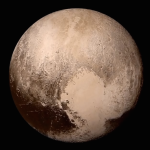 NASA releases a sharper image of Pluto showing that the left half of the Tombaugh Regio heart region is different than the right. The left half is more filled in. Scientists believe some process, possibly wind, is blowing material from the left half to the right half.
NASA releases a sharper image of Pluto showing that the left half of the Tombaugh Regio heart region is different than the right. The left half is more filled in. Scientists believe some process, possibly wind, is blowing material from the left half to the right half.
Our interpretation is that material in the right lobe — the source for that material — is coming from the western [or left] lobe.
Glaciers
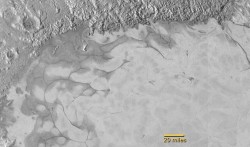 NASA releases a photo which suggests that glaciers are flowing on Pluto’s surface in the region of Sputnik Planum. Scientists believe the ice is made of nitrogen, carbon monoxide and methane.
NASA releases a photo which suggests that glaciers are flowing on Pluto’s surface in the region of Sputnik Planum. Scientists believe the ice is made of nitrogen, carbon monoxide and methane.
To see evidence of recent geological activity is simply a dream come true. The appearance of this terrain, the utter lack of impact craters on Sputnik Planum, tells us that this is really a young unit.
Eclipses the sun
 NASA releases a photo of Pluto eclipsing the sun showing a haze in Pluto’s atmosphere which extends at least 160 km (100 miles) above the surface.
NASA releases a photo of Pluto eclipsing the sun showing a haze in Pluto’s atmosphere which extends at least 160 km (100 miles) above the surface.
This is one of our first images of Pluto’s atmosphere. [It] stunned the encounter team. For 25 years, we’ve known that Pluto has an atmosphere. But it’s been known by numbers. This is our first picture. This is the first time we’ve really seen it. This was the image that almost brought tears to the eyes of the atmospheric scientists on our team.
Pluto and Charon’s natural color
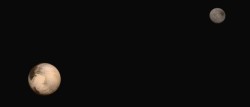 NASA releases this photo which shows Pluto’s reddish color and Charon’s gray tone. Scientists think Pluto’s red color is the result of particles created in its atmosphere, through methane’s interaction with UV light. The particles stick together, growing heavier, and eventually rain down on the surface. Observations show that Charon does not have much of an atmosphere.
NASA releases this photo which shows Pluto’s reddish color and Charon’s gray tone. Scientists think Pluto’s red color is the result of particles created in its atmosphere, through methane’s interaction with UV light. The particles stick together, growing heavier, and eventually rain down on the surface. Observations show that Charon does not have much of an atmosphere.
For now, all that we can say is, it’s a much more rarefied atmosphere [than Pluto’s]. It may be that there’s a thin nitrogen layer in the atmosphere, or methane, or some other constituent. But it must be very tenuous compared to Pluto — again, emphasizing just how different these two objects are despite their close association in space.
Earth-like world discovered
NASA’s Kepler mission discovers Kepler-452b, the first near-Earth-size planet in the habitable zone around a sun-like star. 425b is located about 1,400 light years away in the Constellation Cygnus, orbiting a star slightly brighter than the sun. The planet is about 60% larger than Earth and about 1.5 billion years. There is no evidence that it has an atmosphere.
We can think of Kepler-452b as an older, bigger cousin to Earth, providing an opportunity to understand and reflect upon Earth’s evolving environment. It’s awe-inspiring to consider that this planet has spent six billion years in the habitable zone of its star; longer than Earth. That’s substantial opportunity for life to arise, should all the necessary ingredients and conditions for life exist on this planet.
Discovers second mountain range
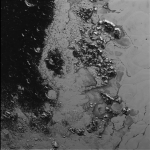 NASA releases a photo showing another mountain range on the lower left edge of Pluto’s heart-shaped region. The peaks are about 1 to 1.5 km (0.5 to 1 mile) high, about the size of the Appalachians. The new range is just west of the region within Pluto’s heart called Sputnik Planum (Sputnik Plain) and some 110 km (68 miles) northwest of Norgay Montes. This newest image further illustrates the remarkably well-defined topography along the western edge of Tombaugh Regio.
NASA releases a photo showing another mountain range on the lower left edge of Pluto’s heart-shaped region. The peaks are about 1 to 1.5 km (0.5 to 1 mile) high, about the size of the Appalachians. The new range is just west of the region within Pluto’s heart called Sputnik Planum (Sputnik Plain) and some 110 km (68 miles) northwest of Norgay Montes. This newest image further illustrates the remarkably well-defined topography along the western edge of Tombaugh Regio.
There is a pronounced difference in texture between the younger, frozen plains to the east and the dark, heavily-cratered terrain to the west. There’s a complex interaction going on between the bright and the dark materials that we’re still trying to understand.

